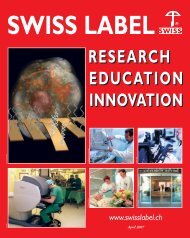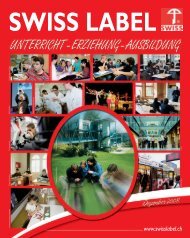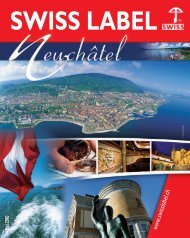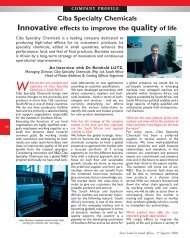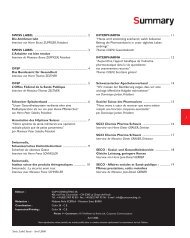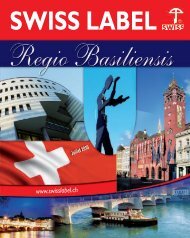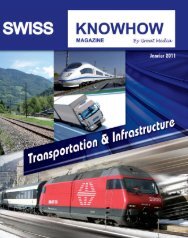SWISS LABEL INFORMATIQUE-XP - Com Consulting SA
SWISS LABEL INFORMATIQUE-XP - Com Consulting SA
SWISS LABEL INFORMATIQUE-XP - Com Consulting SA
You also want an ePaper? Increase the reach of your titles
YUMPU automatically turns print PDFs into web optimized ePapers that Google loves.
Links between the CHUV and the FacultyInterview with Professor Patrick Francioli, Dean of the Faculty of Biology andMedicine and head of training and research at the CHUVThe importance of training and research is fundamental to CHUV. Every year the University of Lausanne gives the hospitala subsidy of 105 million francs for academic activities, including a 25% “overhead” payment. Most of these resources areallocated directly to the departments. An initiative is currently under way to establish how these are used and to make anyadjustments that may be required. The UNIL subsidy also pays for a unit set up in 2007, the training and researchdepartment, which includes a number of research support units. Professor Francioli untangles the web of a rather complexorganisation.What are the links that exist between the Faculty of Biology and Medicineand the CHUV?The Faculty of Biology and Medicine is divided into two sections, onefor basic sciences, which is linked administratively to UNIL, andanother for clinical sciences, which is attached to the CHUV. At anacademic level, these sections come under the responsibility of theDeanship and the Dean, who in turn reports to the UNIL-CHUVExecutive <strong>Com</strong>mittee, in other words the Rector and the Chief Executive.The Dean is also a member of the CHUV board of management. TheCHUV training and research department includes units that providesupport to researchers, including around ten technology platformsoffering facilities to researchers working either for the CHUV or forthe department of basic sciences. The department also includes theUniversity Medical Library, the Centre of Medical and AudiovisualEducation (CEMCAV), the CHUV animal supply facility and thetechnology transfer unit, known as PACTT. The Faculty includes aschool of medicine, a school of biology, a graduate school and acontinuous and postgraduate training school, which comes under thejoint responsibility of the CHUV and the Faculty.medical studies, Professor Jean-Daniel Tissot, who is also head of thepostgraduate and continuous training school, to incorporate thistraining in a proper institutional study programme. The finance, whichis a subject of discussion wherever you go in Switzerland, is beingprovided by a cantonal grant.There is a “transition unit” within the Deanship.It plans academic transition by defining the requirements, advertisingjobs and suggesting promotions. The Faculty’s research committee alsoplays a role in this by making available research grants to talentedyoung researchers. However, this is not enough and we need to findnew routes that will allow clinicians with an academic vocation topursue their clinical training simultaneously. People who are capableof pursuing this type of career need to make a name for themselvespretty early on, given the length of the training courses. It is not easy,and often exhausting in the context of a chronically overburdenedhospital, to juggle clinical training with proving your skills as aresearcher and teacher. We are trying to set up an incentive policy, forexample by providing free time for research during working hours. Wehave to do something otherwise we will not have enough cliniciansand researchers in future. The new rules dictating that trainees canwork no more than 50 hours a week are making things very difficultand it is clear that those with academic ambition will have to put inextra personal effort.15© CEMCAV-CHUV, Willy BLANCHARDStudents at the microscope / Etudiants au microscopeWho defines the highly specialised content of this postgraduate training?The Swiss Medical Association (FMH) has supreme control over thesetraining courses which lead to specialties and are genuine “trade”apprenticeships. The FMH sets the requirements, but its authority hasbeen questioned in recent years, in particular by the universityhospitals and universities responsible for providing most of thesetraining programmes and who wish to have more say in the matter. Atthe CHUV, there is currently an idea, started by the director ofWhat are the activities of the “technology transfer” unit?The aim is to develop the discoveries made by the researchers at UNILand the CHUV. It acts as both a help and a safeguard. This unit playsthe role of facilitator for researchers, for example by helping them toregister patents, and to find industrial or even financial partners. Italso exercises a control function, by checking that contracts signedwith industry or other agents comply with the law and with the interestsof the institutions and the researchers. There are also rules about thesharing of any royalties between researchers and the institution.CHUV – Département formation et rechercheRue du Bugnon 21 - CH-1011 LausanneTél.: +41(0)21 692 50 19E-mail : Patrick.Francioli@unil.chSite internet :http://www.chuv.ch/chuv_home/chuv_qui_sommes_nous/chuv_organisation.htmSwiss Label CHUV 2010



